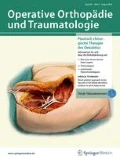Zusammenfassung
Operationsziel
Anatomisch korrekte Reposition und Stabilisierung der Fraktur bei dislozierten Verletzungen.
Indikationen
Dislozierte Epiphyseolysen vom Typ Harris-Salter I und II des distalen Femurs und der proximalen Tibia.
Kontraindikationen
Allgemeine Kontraindikationen für Narkose und Operation sowie nichtdislozierte Verletzungen.
Operationstechnik
Die Fraktur wird zunächst geschlossen reponiert und anschließend mittels gekreuzter, perkutan eingebrachter Kirschner-Drähte stabilisiert. Ist eine geschlossene Reposition nicht möglich, muss eine möglichst schonende offene Reposition über einen kleinen medialen oder lateralen Zugang durchgeführt werden. Bei ausgewählten Verletzungen mit großem metaphysärem Keil erfolgt die Retention mit parallel zur Wachstumsfuge eingebrachten Zugschrauben.
Weiterbehandlung
Zur Nachbehandlung der operativ versorgten Epiphyseolyse am distalen Femur sollte für 4–6 Wochen ein Becken-Bein-Gipsverband angelegt werden. Epiphyseolysen an der proximalen Tibia werden für den gleichen Zeitraum in einem Oberschenkelgipsverband ruhig gestellt.
Ergebnisse
Die Komplikationsrate nach Epiphyseolyse des distalen Femurs beträgt nach Studienanalysen ca. 37–70%. Zur Epiphyseolyse der proximalen Tibia liegen keine aussagekräftigen Studien vor.
Abstract
Objective
Anatomic reduction and stabilization in case of dislocated injuries.
Indications
Dislocated epiphysiolyses types Harris-Salter I and II of the distal femur and the proximal tibia.
Contraindications
General contraindications to anesthesia and surgical treatment as well as nondislocated injuries.
Surgical Technique
After initial closed anatomic reduction, the fracture is stabilized with crossing Kirschner wires. If closed reduction is not successful, open reduction via a small medial or lateral incision becomes necessary. Selected injuries with a big metaphyseal wedge should be stabilized with screws, which are inserted parallel to the physis.
Postoperative Management
Postoperative management of epiphysiolyses of the distal femur requires a pelvic leg cast for 4–6 weeks. In epiphysiolyses of the proximal tibia, a long-leg cast is adequate.
Results
According to studies, complications after epiphysiolysis of the distal femur occur in 37–70%. Sound studies concerning epiphysiolysis of the proximal tibia do not exist.
Author information
Authors and Affiliations
Corresponding author
Rights and permissions
About this article
Cite this article
Oberle, M., Bonetta, M. & Schlickewei, W. Operative Therapie der kniegelenknahen Epiphyseolyse. Orthop Traumatol 20, 387–395 (2008). https://doi.org/10.1007/s00064-008-1410-z
Published:
Issue Date:
DOI: https://doi.org/10.1007/s00064-008-1410-z

